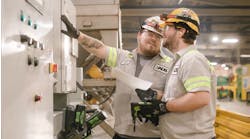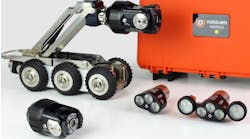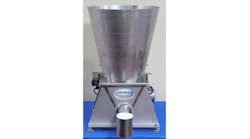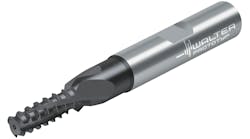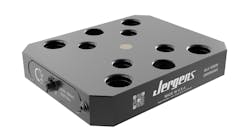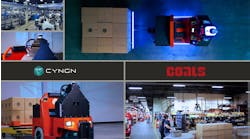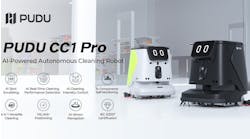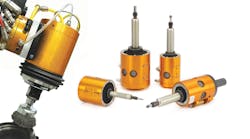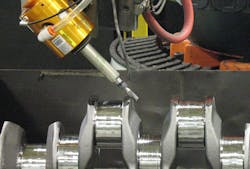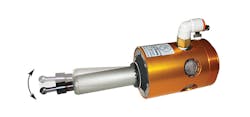In the Industry 4.0 era, labor-intensive, repetitive tasks are starting to disappear from job descriptions. Many of the advanced-manufacturing technologies designed to boost productivity and efficiency in the smart factory, such as robotics and automation, are also behind this change.
Material removal is one example of a labor-intensive task that is becoming more automated with the help of robotics. Traditionally, material removal—including deburring, grinding, and brushing—has been a manual operation because of limitations in automated deburring tools.
"It's not a job that most people want to do, and it comes with health risks," says Dan Merritt, Material Removal Product Manager, ATI Industrial Automation.
"Manual material removal puts workers at risk for carpal tunnel syndrome, back issues, and fatigue," Merritt says. It also tends to be less precise and prone to errors and defects. Advancements in automated material removal technology are reducing machine operators' reliance on these manual processes. This includes integrated compliance capabilities to perform deburring, deflashing, edge breaking, or surface-finishing operations.
"It's a way to control force and get consistency with the way the tool contacts the part," Merritt explains.
Compliant, Smart Tooling
Manual material removal typically involves the use of a handheld tool such as a die grinder, sander or angle grinder to remove the unwanted material from the part.
"It's a dull, dangerous job, and because of that, we're seeing a boon in the marketplace for automation in this area," Merritt says.
The unforgiving nature of rigid deburring tools on robots yields inconsistent results. This is due to part variability, lack of fixture repeatability, and variation of the excess material. Deburring tools with integrated compliance can compensate for these variations. Compliance also simplifies robot programming of complicated part geometries and complex tool paths.
"It's a difficult process to automate due to factors involved with material removal," Merritt says. "Humans have sight and can identify high spots or low spots and can feel how hard they're pressing on a part—things robots don't have inherently."
ATI, a manufacturer of robotic accessories and robotic arm tooling, has developed three types of compliant material-removal tools designed to improve the safety and consistency of automated material removal. They include:
- Radially-Compliant deburring tools, which are turbine-driven units for deburring a variety of materials with a robot or CNC machine. Radially compliant deburring tools are particularly suited for removing parting lines or flash from parts.
- Axially-Compliant finishing tools, which are low-speed, high-torque air tools with an axially floating spindle, suitable for various robotic and non-robotic material finishing operations on a wide range of materials, including aluminum, plastic, and steel.
- Axially-Compliant deburring tools that utilize a vane-type motor and a floating rotary cutting file for edge-deburring and chamfering of parts using a robot.
"Robotic material-removal tools are widely used in the die castings, sand casting and machined parts markets," Merritt says. ATI also is seeing increasing demand in industries where they use composite materials, such the aerospace industry.
"We're getting more inquiries and the challenges manufacturers are trying to address are more varied," he says. "For example, we're seeing more demand for aerospace turbine blades and carbon fiber composite materials."
Raising the Bar on Quality and Skills
Some of the obvious benefits related to any automated task include increases in efficiency and safety. Additionally, automated material removal may lead to higher quality, reduced scrap rates, and increases in employee morale and engagement.
The precise nature of compliant material-removal tools reduces the likelihood of defects that can occur during manual deburring or finishing processes.
"If a worker has 20 or 30 features to grind down or polish on a part, that's a lot for a person to handle, and they may miss something that results in scrap," Merritt says. "Quality and consistency are things automation can address."
"In turn, workers spend more time applying their core skills to tasks, such as programming or loading the robot or quality inspections. One manufacturer of connecting rods for auto engines has been able to reassign workers to other areas after installing robotic finishing tools," Merritt says.
"The people who were doing that job are now focused on loading or unloading and maintenance instead of just grinding that rod every day," he explains. "It's increased throughput and elevated the job status of employees."
Seek Expert Advice
"Implementing robotic tooling can seem like a complex process, particularly for smaller plants and machine shops that lack existing automation. Suppliers, such as ATI, can help manufacturers overcome implementation challenges by offering expertise throughout the process," Merritt says.
"This isn't a process where you look in a catalog, buy a part, bolt it on, and go," he says. "We help customers on the front end to understand what the challenges are. For example, we can help them determine whether a brush or abrasive would be better. It's an iterative process, which requires experimentation with many variables, such as media type, compliance force, and robot speed."
For more robotic deburring information, visit: www.ati-ia.com

